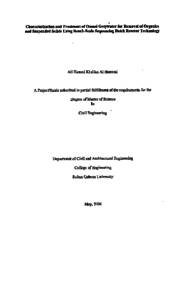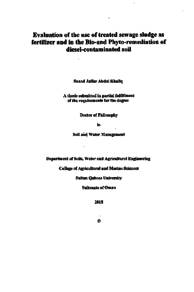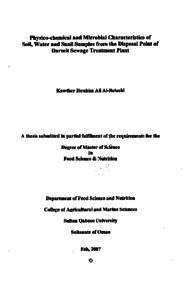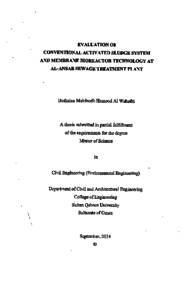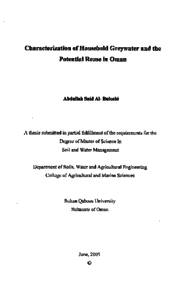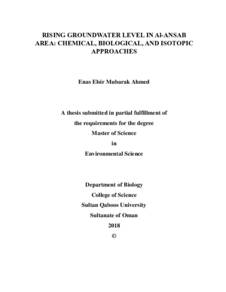وثيقة
Characterization and treatment of Omani greywater for removal of organics and suspended solids using bench-scale sequencing batch reactor technology.
الناشر
Sultan Qaboos University
ميلادي
2006
اللغة
الأنجليزية
الموضوع
الملخص الإنجليزي
This study aims to evaluate the potential of greywater availability and its quality in Muscat Governorate, Sultanate of Oman in order to assess the reuse options. The main objectives is to evaluate the applicability of sequencing batch reactor (SBR) process in treatment of greywater and to investigate the effect of cycle time on the sequencing batch reactor (SBR) treatment of Omani greywater. The greywater production is approximately
81% of the fresh water consumption (140L/Capita/Day) and most of the greywater is generated from showers. Greywater samples were collected from showers, laundries, kitchens and sinks from different houses and analyzed for water quality parameters, which suggested that greywater contains significant levels of suspended solids, inorganic constituents, total organic carbon, chemical oxygen demand (COD), Biochemical oxygen
demand (BOD), total Coliforms and Escherichia Coliform bacteria. A pilot scale sequencing batch reactor (SBR) was operated to study the organic removal of greywater. Experiments were run for cycle time of 3hrs, 4hrs, 5hrs, 6hrs and 7hrs. In all experiments, the react phase period was 1.5 times the fill phase period. Experimental results showed that the highest COD and suspended solids (SS) removal for the treatment of greywater using
SBR technology were obtained with react period of 3 hour and duration of fill phase of 2 hours. Removal percentage ranged between 50% to 83% for COD and 90% to 100% for . Survey was carried out to assess the public interest in treated greywater reuse. Results indicated that 87% of the people accepted greywater reuse for gardening, car washing, toilet flushing and potable purposes whereas 5.3% opposed reuse of greywater due to
possible health hazards, environment and groundwater pollution, religious beliefs and economical feasibility.
الوصف
Thesis
المجموعة
URL المصدر
الملخص العربي
أن شح مصادر المياه في معظم أقطار الوطن العربي يشكل تحديا للكثير من الحكومات وفي بلد كسلطنة
عمان والتي تمتلك مصادر محدودة من المياه فان المحافظة على الموارد المائية المتوفرة يجب أن يحظى بالاهتمام
الأكبر من قبل المجتمع بشكل عام . وتعتبر إعادة استخدام المياه الرمادية واحدة من هذه الإستراتيجيات بغرض تقليل
الضغط على المياه العذبة ومحاولة إيجاد توازن مائي بين الاستهلاك في المياه والمصادر المائية.
تهدف
هذه الدراسة إلى قياس
كميات المياه الرمادية ومعرفة قابلية الناس
لإعادة استعمال هذه المياه وتحليل
خصائصها الفيزيائية والكيمائية والبيولوجية ومحاولة إيجاد علاقات ثابتة فيما بين هذه الخصائص
ومن ثم دراسة
طرق معالجتها في السلطنة.
وقد أظهرت نتائج هذه الدراسة التي أجريت في محافظة مسقط أن حوالي 81% من المياه المستهلكة يوميا
للفرد الواحد هي مياه رمادية ومعظمها يأتي من مياه الاستحمام. وكما أظهرت النتائج نسب مختلفة من البكتيريا
:
ومسببات الأمراض
مما يستدعي الحذر عند التعامل مع هذه المياه. وأخيرا أثبتت الدراسة أن معالجة هذه المياه
بطريقة الحوض المتتالي المراحل فعالة وأظهرت نتائج جيدة.
عمان والتي تمتلك مصادر محدودة من المياه فان المحافظة على الموارد المائية المتوفرة يجب أن يحظى بالاهتمام
الأكبر من قبل المجتمع بشكل عام . وتعتبر إعادة استخدام المياه الرمادية واحدة من هذه الإستراتيجيات بغرض تقليل
الضغط على المياه العذبة ومحاولة إيجاد توازن مائي بين الاستهلاك في المياه والمصادر المائية.
تهدف
هذه الدراسة إلى قياس
كميات المياه الرمادية ومعرفة قابلية الناس
لإعادة استعمال هذه المياه وتحليل
خصائصها الفيزيائية والكيمائية والبيولوجية ومحاولة إيجاد علاقات ثابتة فيما بين هذه الخصائص
ومن ثم دراسة
طرق معالجتها في السلطنة.
وقد أظهرت نتائج هذه الدراسة التي أجريت في محافظة مسقط أن حوالي 81% من المياه المستهلكة يوميا
للفرد الواحد هي مياه رمادية ومعظمها يأتي من مياه الاستحمام. وكما أظهرت النتائج نسب مختلفة من البكتيريا
:
ومسببات الأمراض
مما يستدعي الحذر عند التعامل مع هذه المياه. وأخيرا أثبتت الدراسة أن معالجة هذه المياه
بطريقة الحوض المتتالي المراحل فعالة وأظهرت نتائج جيدة.
قالب العنصر
الرسائل والأطروحات الجامعية

